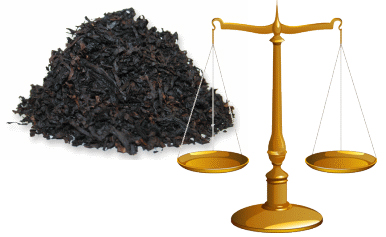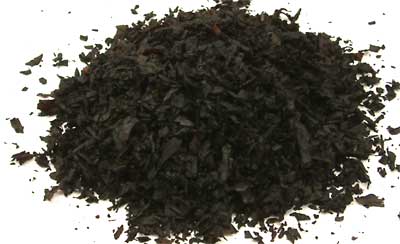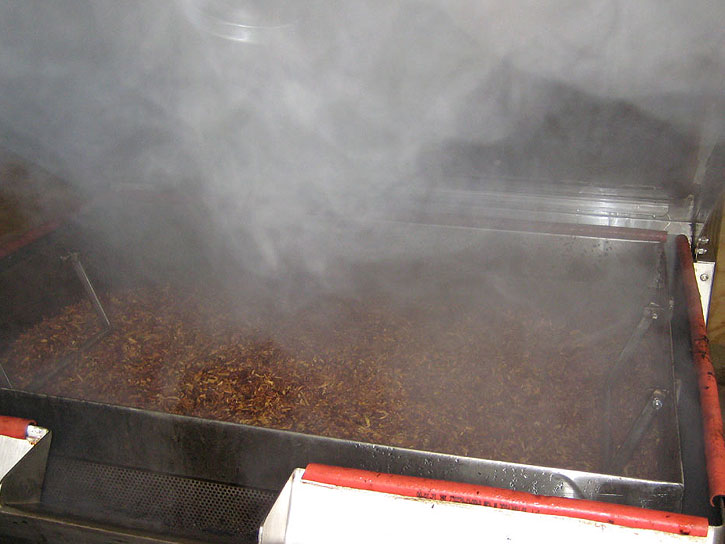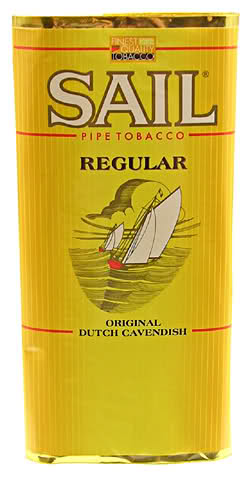If perique is the pepper of the tobacco world, if latakia is the salt, then cavendish is the sugar. Often it is used in aromatics and it is a good tobacco for beginning pipe smokers.
Almost all types of pipe tobacco in general belong to one of two groups: those used as the “base” of a mixture (like burley and Virginia) and those used for adding flavour, taste and aroma to a blend (such as latakia, perique and orientals. But cavendish can be used both as a base and as a flavouring agent.
Cavendish is a description of a type of pipe tobacco and a manner in which tobacco is cut. It is not a type of tobacco plant. It rather is a process by which tobaccos are prepared. So there is no tobacco grown anywhere in the world that is known as a cavendish tobacco.
Now some history. In 1585 a visit to the English colony of Virginia was made by Admiral Sir Richard Grenville and Sir Thomas Cavendish at the request of Queen Elizabeth. The native people of the area presented tobacco to the colonists and Sir Thomas wished to bring it back to England for promotion and selling. On the return voyage he infused his personal supply with dark rum. Thus preventing it from drying out and to sweeten the smoke. He then rolled the leaves (common practice of the sailors back then) and bound them tightly together with sail canvas and twine. After a few weeks the tobacco was cut in little slices and smoked. Remarkably the flavour had improved, the tobacco was sweeter, more mellow and it demonstrated an aromatic fragrance. That all pleased Sir Thomas and others who tried it.
So cavendish tobacco simply is a product of “double” fermentation. This process uses (already one-time fermented) air-cured or flue-cured tobaccos like Virginia, burley, Maryland or any combination of these three types. These can be infused with substances that are high in sugar like: rum, maple, sugar, chocolate, licorice, honey, fruit, vanilla, bourbon and a few more. After the infusion the tobacco is compressed, steamed, heated, fermented and aged for a period of time. This results in a compressed “cake” of tobacco that is sliced and/or rubbed-out. For example, untreated, bright leaf (Virginia) tends to burn very hot and fast with a light, sharp flavour. The cavendish process makes this a more pleasant product. The tobacco is aged longer, burns slower, has a better taste and important, the ladies love the smell.
In the ol’ days the creation of cavendish tobacco varied from country to country and from manufacturer to manufacturer. Nowadays the whole process is more standardized and it doesn’t matter that much from which country cavendish comes. There are even manufacturers who don’t make their own cavendish any more because of the long process and just buy it ready-made. The countries which originally produced the most widely known cavendish tobaccos were: The United States, The United Kingdom, Denmark and last but not least The Netherlands. And they all had different production methods:
Cavendish manufactured in the United States
In order to get the tobacco to accept the required amount of casings it may be dipped (especially the burleys) into a casing sauce or heavily sprayed with flavouring sauces. The tobacco was then allowed to rest for a period of time. This way the tobacco and casings were wedded after which it may be subjected to pressure. It could take weeks or months until the blend had properly accepted the casing materials. The colour of the processed cavendish ranged from a light brown to black, depending on the leaf and casings used.
Cavendish Manufactured in the United Kingdom
The English manufactured their cavendish only with a heavier grade of Virginia. The tobacco was placed in molds and subjected to heavy pressure for three to four days. The pressure on the tobacco caused the natural oils to rise. Because of the heavy natural sugar content of the Virginia leaf the tobacco developed a sweet taste.
Cavendish Manufactured in Denmark and The Netherlands
We Dutch and the Danes employed a slow manufacturing method. First steaming the tobacco to open the pores and then casing it very heavily. It was then placed in molds and subjected to pressure until a cake was formed which could be cut into bars an then into smaller pieces.
Black Cavendish
Then we also have the so called “black cavendish”. The two important steps employed in all manufacturing of black cavendish are:
1. The dipping of the tobacco into various casing, flavouring sauces (usually licorice) and
2. The steaming of the tobacco which turns it black.
For the rest the process is the same as with regular cavendish.
Black cavendish tobaccos can be manufactured from either Burley or Virginia leaf. Usually, the heavier and darker leaf grades are used. Since this tobacco is heavily impregnated with flavourings, the taste is naturally influenced by those.
The British also made black cavendish. The only difference is the restricted use of additives which made the taste more natural. So the usual method of processing this tobacco is to “sweat” and steam it. Which causes it to turn black. The tobacco is then placed in a mold and subjected to pressure for one to several days until a cake is formed. During this phase, additional steam may be applied.
As I said above cavendish also is a manner in which tobacco is cut. The term “cavendish cut” simply means a type of cut that is between a long or ribbon cut and a heavy fine cut.
 Many smokers prefer to smoke straight cavendish. But it is often blended with other tobaccos such as burleys and Virginias. If you are making your own blend, start by mixing equal amounts of unflavoured cavendish and burley. This will give you some idea of the use of cavendish as a base. If you wish you can keep adding it until it makes up as much as 90% of the mixture. What you can also do is to take plain white burley. Then add for example about 25% cavendish flavoured with honey (or another flavour) to the blend. This way you will get a mild smoke with very little aroma. When you use cavendish together with latakia and orientals (an English or Balkan mixture) about 15% is the max.
Many smokers prefer to smoke straight cavendish. But it is often blended with other tobaccos such as burleys and Virginias. If you are making your own blend, start by mixing equal amounts of unflavoured cavendish and burley. This will give you some idea of the use of cavendish as a base. If you wish you can keep adding it until it makes up as much as 90% of the mixture. What you can also do is to take plain white burley. Then add for example about 25% cavendish flavoured with honey (or another flavour) to the blend. This way you will get a mild smoke with very little aroma. When you use cavendish together with latakia and orientals (an English or Balkan mixture) about 15% is the max.
There are many, many, many blends that use cavendish. This are the most recommended ones:
– Amphora: Full Aroma*
– Borkum Riff: Cherry Cavendish*
– Cornell & Diehl: Autumn Evening
– DTM: BiBo, Blue Note, Memories of Tuscany
– Just For Him: Shortcut to Mushrooms
– HU Tobacco: Geniet Moment
– Lane Ltd.: Captain Black White, 1-Q
– Mac Baren: 7 Seas Regular Blend*, 7 Seas Royal Blend*
– Neptune*
– Planta: Danish Black Vanilla Flake, Pergamon
– Poul Winslow: Harlekin*, No. 1*
– Sail: Regular*
– Samuel Gawith: Black Cherry, Celtic Talisman
– Sillem’s: Black
– Stanwell: Melange*
– Troost: Aromatic Cavendish*, Black Cavendish*, Special Cavendish*
– WO Larsen: Black Diamond, Mellow Mixture*, Sweet Aromatic*
* Available in The Netherlands
EDIT: I see there is some confusion between English pressed Virginia flakes, cavendish and black cavendish.
– English cavendish is made without the steaming under high pressure in 3 to 4 days.
– English black cavendish is made with steaming the tobacco under high pressure in 1 to 2 days.
– An English pressed Virginia flake, like Samuel Gawith’s Full Virginia Flake, gets about 4.5 hours of steam pressure, then slowly cools in the press overnight. In the morning they take it out. It is still warm then but it has slow-cooled for 12 hours. Golden Glow gets about 2.5 hours of steam pressing before cooling overnight.
So the process of pressed English Virgina flakes is in essence the same as with cavendish. Only the time is much, much shorter.





Both SG Full Virginia Flake and Golden Glow are among my favourites. The FVF also functions as a very good blending tobacco, btw.
Hello Atboth, nice to see you here! I should talk Dutch right? 😉
I never used FVF as a blending tobacco. Actually, I am a bit afraid to use it because of it’s high nicotine content..
Purely hypothetical full English using FVF:
Six parts Latakia.
Five parts Full Virginia Flake.
Two parts Turkish.
One part Red Virginia Ribbon.
The Turkish and Latakia will both decrease the nicotine content, and the red ribbon will make it a looser more smokeable mixture.
Hmm… That sounds interesting. Thanks! When I crack open a FVF tin I shall give it a try. Would Red Virginia Cavendish also be ok? I don’t have the ribbon cut version..
I would be inclined to use Baai tabak instead, as it’s the ribbon-like quality that makes it more smokeable. It adds a ‘fluffyness’. Red VA cavendish, if not sauced, would also, but not quite so much…. Using red VA cavendish, I might increase it to two parts.
? Mixing with baaitabak? Does that taste ok? Which baaitabak would you use? I have loose Maryland mixing tobacco..
Baai Tabak should be mostly or entirely ribbon cut Maryland – De Echte Friesche Heerenbaai, OR Vier Heren Baai, if I remember correctly. If your Maryland is a ribbon-cut, it would be fine instead. Maryland functions like a smoother Burley, with a pleasantly mild finish. It is also considerably lower in Nicotine and far less alkaline, so it would work well with Virginias.
Avoid Baai Tabak that has flavourings or strange foreign leaf added. Though it may actually come from the Mediterraneum now, of all places…. the state of Maryland is trying to discourage the growing of tobacco, and the only other place where the Maryland strain is cultivated seems to be in Italy.
I am afraid baai-tabakken are not what they used to be in your time.. Friesche Heerenbaai is now made by Orlik, read the description: Friesche Heerenbaai is een typische Nederlandse baai-tabak samengesteld uit Virginia uit Brazilië, Tanzania en Thailand, waaraan Burley uit Malawi en India wordt toegevoegd. Zeer fijne snede. De blend wordt afgewerkt met een zoet toparoma. Aroma: Zoet, chocolade.
So it has flavourings…
Vier Heren Baai is not produced any more since Niemeyer was taken over by BAT.
I think my Maryland tobacco is ribbon cut, have to look for that.
I read something like that about Maryland yes.. Such a pity..
Anyway, thanks for the tips!
Good lord, they’ve whored it up! Yes, then by all means use the Maryland blending tobacco.
Yes they raped and mutilated it.. The bastards.. That is why I like the Belgium Semois tobacco so much. All natural.